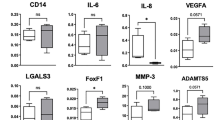Abstract
Ossification of the posterior longitudinal ligament (OPLL) is characterized by ectopic bone formation in spinal ligaments. Some evidence indicates that mechanical strain can lead to the development of OPLL, although the signaling mechanism is not fully understood. Connexin43 (Cx43), a gap-junction protein, has been shown to be of particular importance in bone formation. We hypothesized that Cx43 may play an important role in the signal transmission induced by mechanical strain during the development of OPLL. To explore this possibility, we cultured fibroblasts from spinal ligaments of OPLL and non-OPLL patients and preloaded mechanical stretch onto the cells via a Flexercell 4000 Tension Plus system. We evaluated expression changes in osteocalcin (OCN), alkaline phosphatase (ALP), type I collagen (COL I) and Cx43 via semi-quantitative RT-PCR and western blotting at 12 and 24 h after mechanical strain application in contrast to static conditions. We observed a significant gene up-regulation of OCN, ALP and COL I and Cx43 protein in OPLL cells after mechanical strain application, but no changes in non-OPLL cells. Notably, after RNA interference targeting Cx43 was performed in OPLL cells, we found that there were no significant changes in the expressions of OCN, ALP, COL I and Cx43 after the mechanical strain was applied for 24 h. Thus, we propose that the increase in Cx43 expression induced by mechanical strain in OPLL cells plays an important role in the progression of OPLL.






Similar content being viewed by others
References
Epstein N (2002) Ossification of the cervical posterior longitudinal ligament: a review. Neurosurg Focus 13(2):ECP1 (review)
Koga H, Sakou T, Taketomi E et al (1998) Genetic mapping of ossification of the posterior longitudinal ligament of the spine. Am J Hum Genet 62:1460–1467
Furushima K, Shimo-onoda K, Maeda S et al (2002) Large-scale screening for candidate genes of ossification of the posterior longitudinal ligament of the spine. J Bone Miner Res 17:128–137
Wang PN, Chen SS, Liu HC et al (1999) Ossification of the posterior longitudinal ligament of the spine. A case–control risk factor study. Spine 24:142–144
Iwasaki K, Furukawa K-I, Tanno M et al (2004) Uni-axial cyclic stretch induces Cbfa1 expression in spinal ligament cells derived from patients with ossification of the posterior longitudinal ligament. Calcif Tissue Int 74:448–457
Furukawa K-I (2006) Current topics in pharmacological research on bone metabolism: molecular basis of ectopic bone formation induced by mechanical stress. J Pharmacol Sci 100:201–204
Beyer EC, Paul DL, Goodenough DA et al (1990) Connexin family of gap junction proteins. J Membr Biol 116:187–194
Bruzzone R, White TW, Paul DL et al (1996) Connections with connexins: the molecular basis of direct intercellular signalling. Eur J Biochem 238:1–27
Donahue HJ, McLeod KJ, Rubin CT et al (1995) Cell to cell communication in osteoblastic networks: cell line-dependent hormonal regulation of gap junction function. J Bone Miner Res 10:881–889
Roberto C (2008) Cell–cell communication in the osteoblast/osteocyte lineage. Arch Biochem Biophys 473:188–192
Furlan F, Lecanda F, Screen J, Civitelli R et al (2001) Proliferation, differentiation and apoptosis in connexin43- null osteoblasts. Cell Adhes Commun 8:367–371
Chung DJ, Castro CH, Watkins M et al (2006) Low peak bone mass and attenuated anabolic response to parathyroid hormone in mice with an osteoblast-specific deletion of connexin43. J Cell Sci 119:4187–4198
Kato Y, Iwasaki M, Fuji T et al (1998) Long-term follow-up results of laminectomy for cervical myelopathy caused by ossification of the posterior longitudinal ligament. J Neurosurg 89:217–223
Tokuhashi Y, Ajiro Y, Umezawa N (2009) A patient with two re-surgeries for delayed myelopathy due to progression of ossification of the posterior longitudinal ligaments after cervical laminoplasty. Spine 34(2):E101–E105
Miyagawa J, Tanaka K, Ohkuma T (1983) The range of motion of cervical spine in ossification of the posterior longitudinal ligament. In: Proceeding of the investigation committee on ossification of the spinal ligament. Investigation Committee on Ossification of the Spinal Ligament, Tokyo, pp 168–176 (in Japanese)
Tominaga S (1981) The relationship between dynamic cervical motion and symptoms on myelopathy due to OPLL in the cervical spine. In: Proceeding of the investigation committee on ossification of the spinal ligament. Tokyo: Investigation Committee on Ossification of the Spinal Ligament, pp 136–142 (in Japanese)
Onari K, Akiyama N, Kondo S et al (2001) Long-term follow-up results of anterior interbody fusion applied for cervical myelopathy due to ossification of the posterior longitudinal ligament. Spine 26:448–493
Tanno M, Furukawa KI, Ueyama K et al (2003) Uniaxial cyclic stretch induces osteogenic differentiation and synthesis of bone morphogenetic proteins of spinal ligament cells derived from patients with ossification of the posterior longitudinal ligaments. Bone 33(4):475–484
Jiang JX, Siller-Jackson AJ, Burra S et al (2007) Roles of gap junctions and hemichannels in bone cell functions and in signal transmission of mechanical stress. Front Biosci 12:1450–1462
Allison CS, Yanan L, Amanda M et al (2008) Modulation of osteoblast gap junction connectivity by serum, TNFα, and TRAIL. Exp Cell Res 314:297–308
Gu G, Nars M, Hentune TA et al (2006) Isolated primary osteocytes express functional gap junctions in vitro. Cell Tissue Res 323:263–271
Wendy AC, Carolyn GG, Amanda FT et al (2009) The role of gap junctions in megakaryocyte-mediated osteoblast proliferation and differentiation. Bone 44:80–86
Author information
Authors and Affiliations
Corresponding author
Rights and permissions
About this article
Cite this article
Yang, Hs., Lu, Xh., Chen, Dy. et al. Mechanical strain induces Cx43 expression in spinal ligament fibroblasts derived from patients presenting ossification of the posterior longitudinal ligament. Eur Spine J 20, 1459–1465 (2011). https://doi.org/10.1007/s00586-011-1767-9
Received:
Revised:
Accepted:
Published:
Issue Date:
DOI: https://doi.org/10.1007/s00586-011-1767-9




